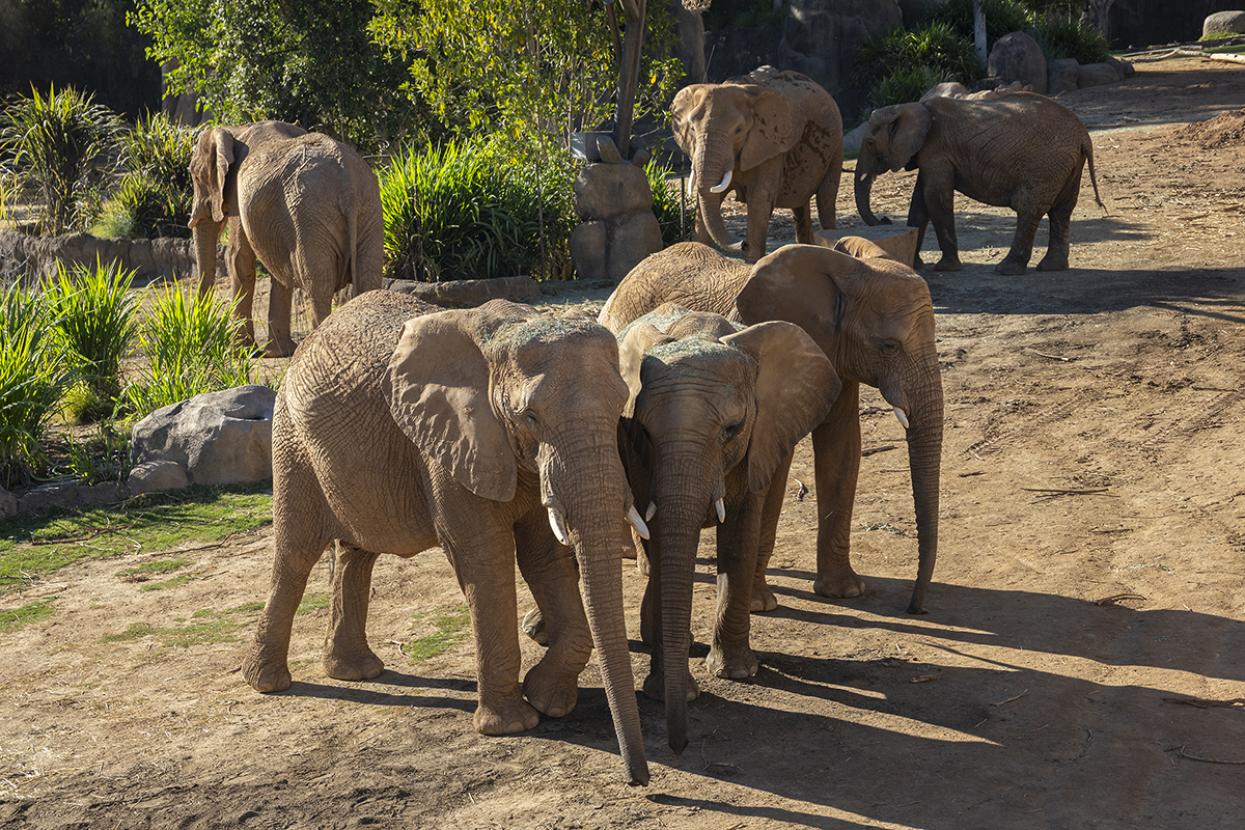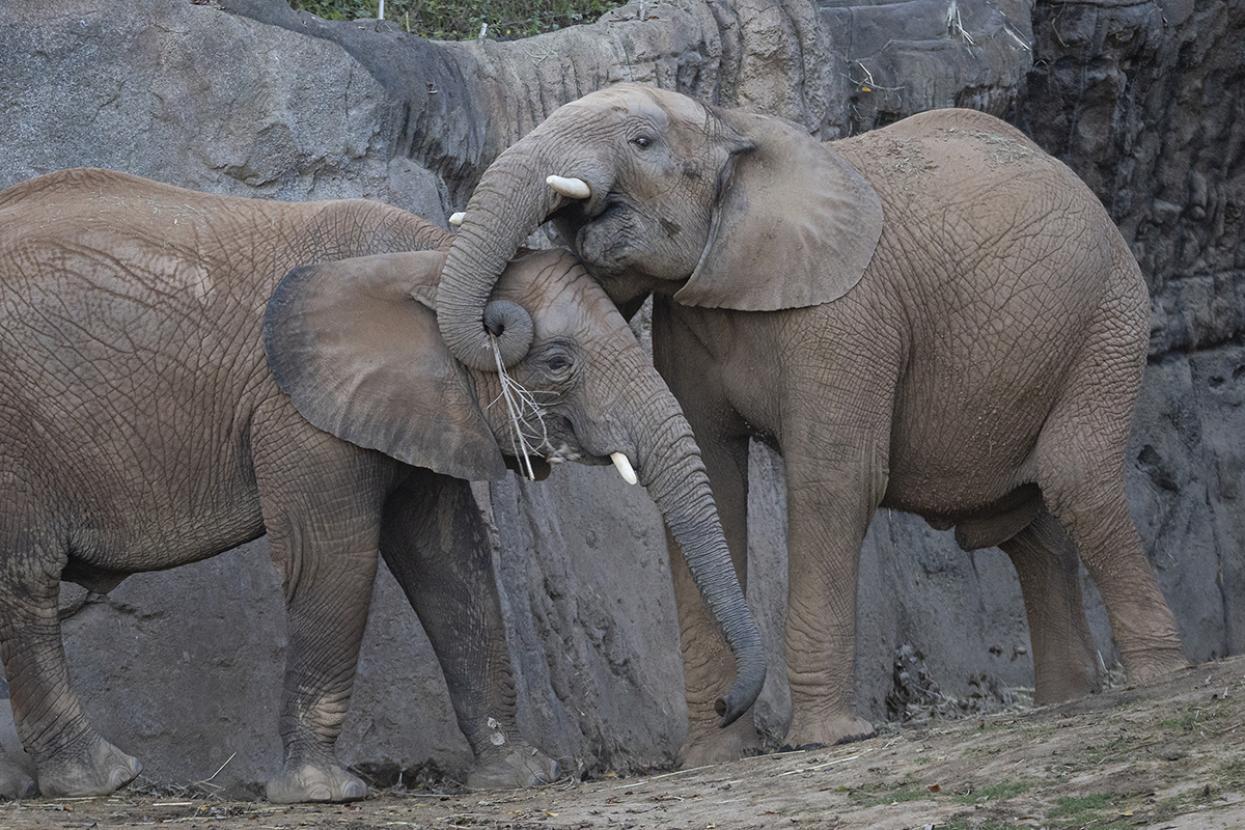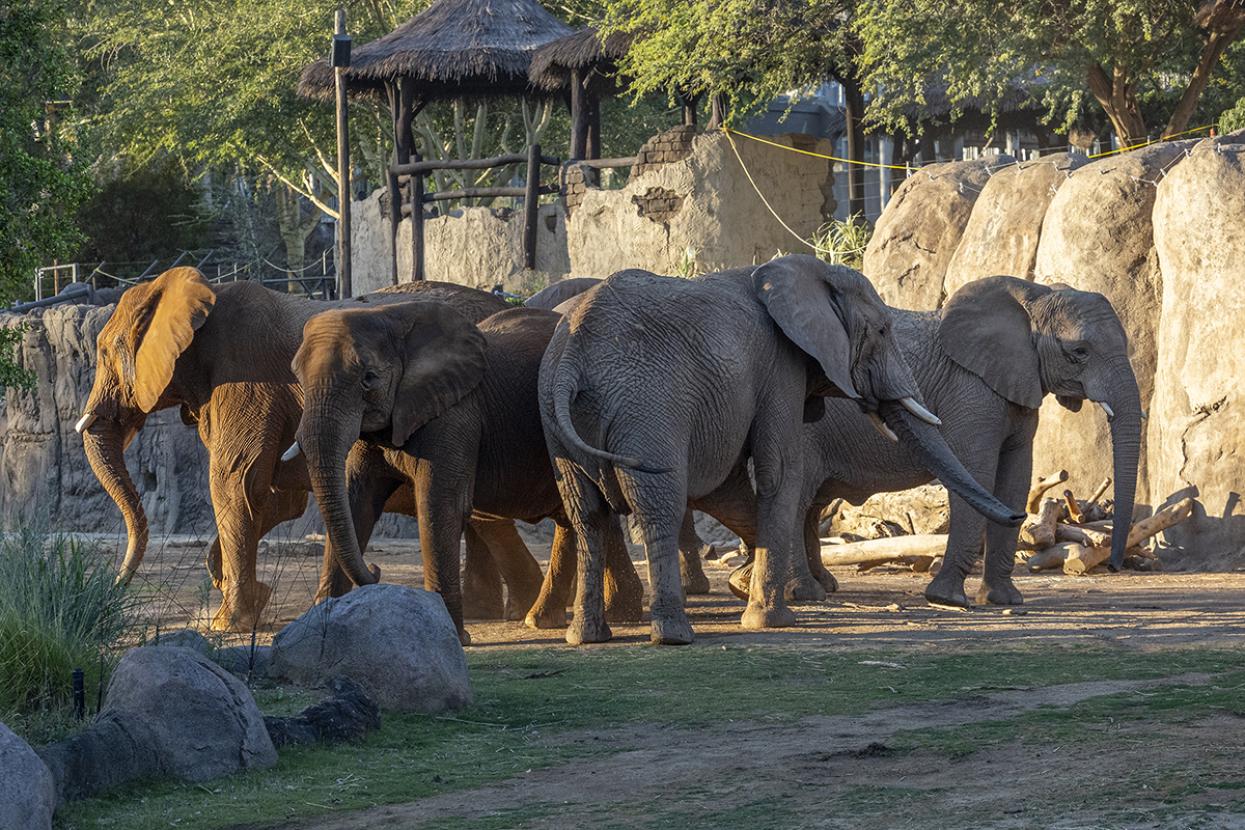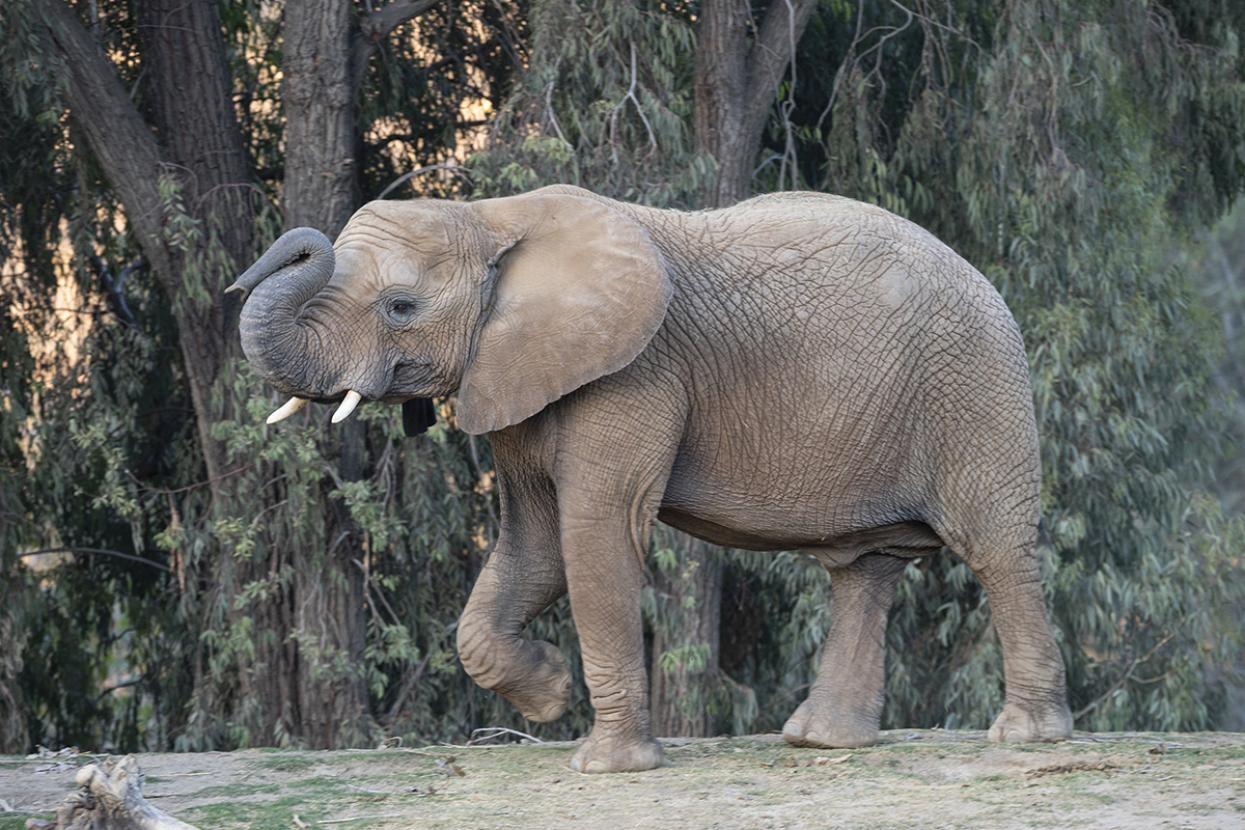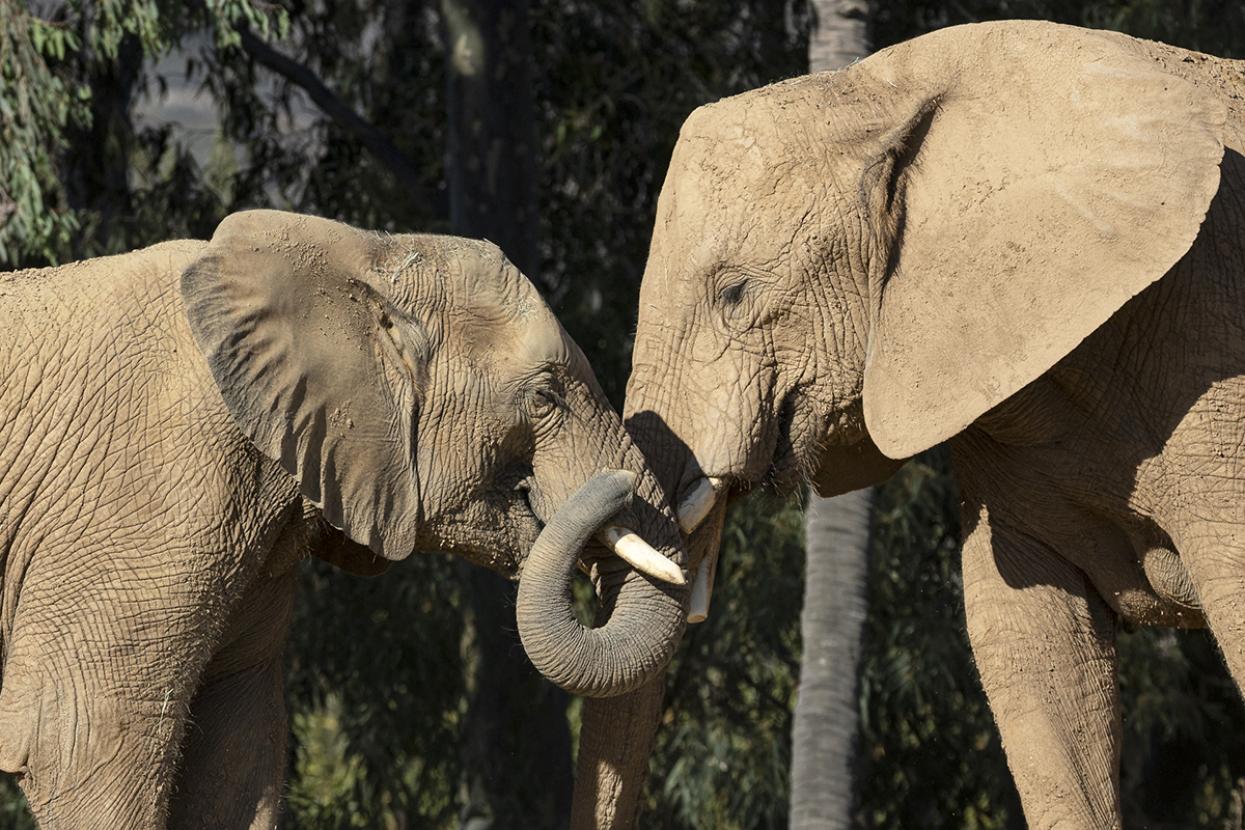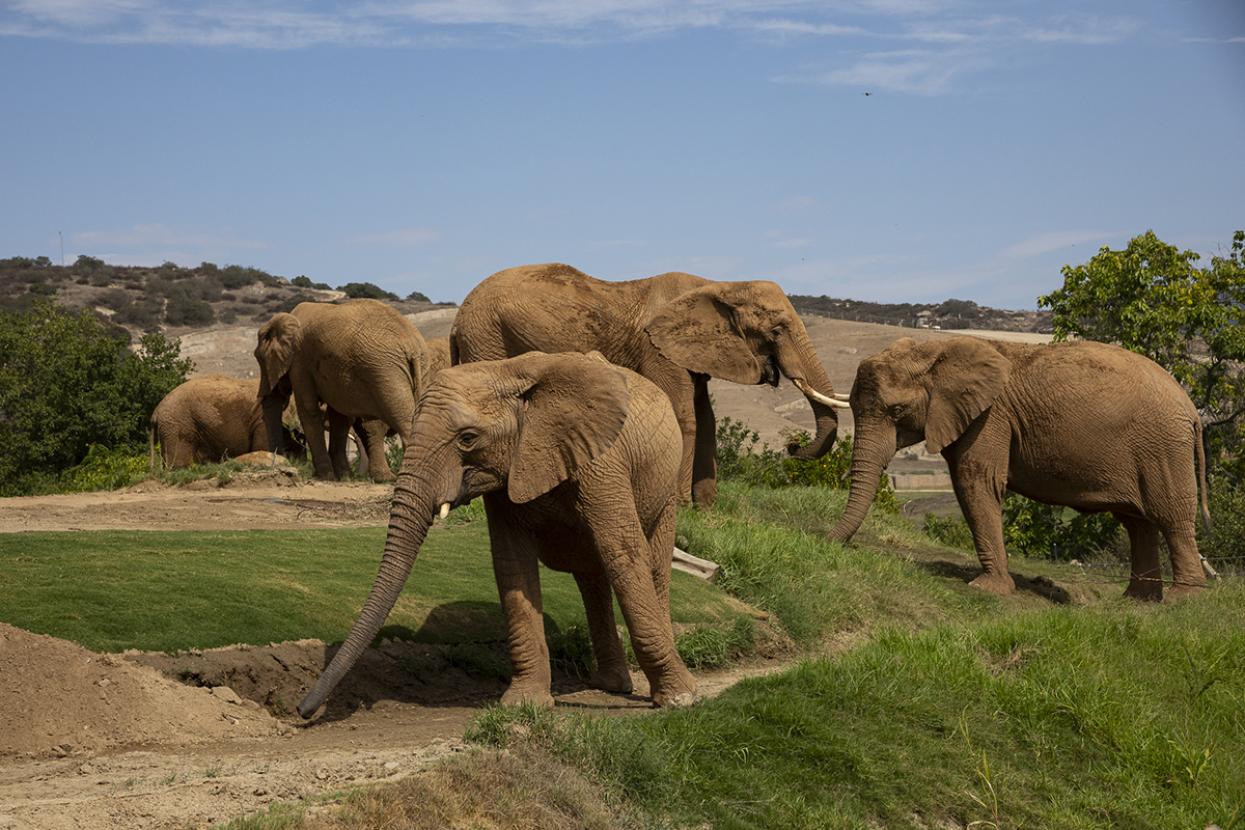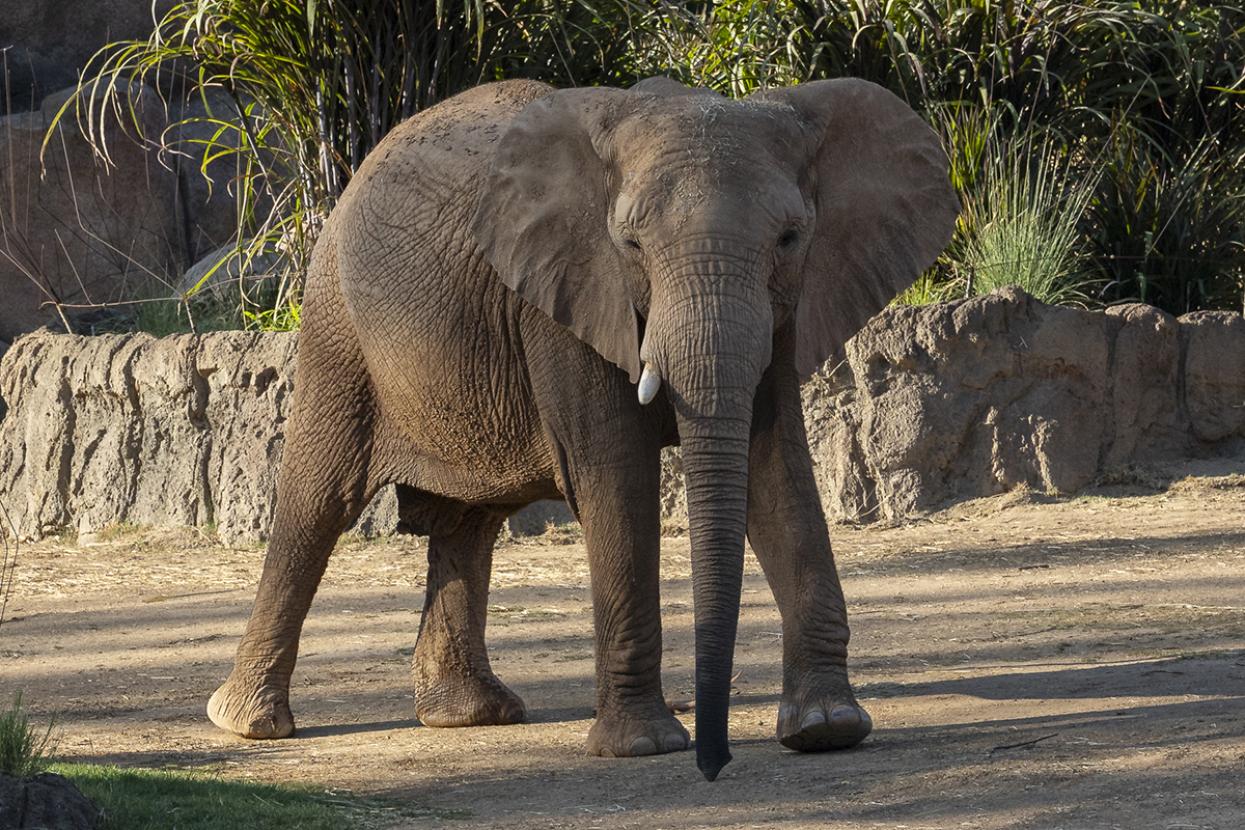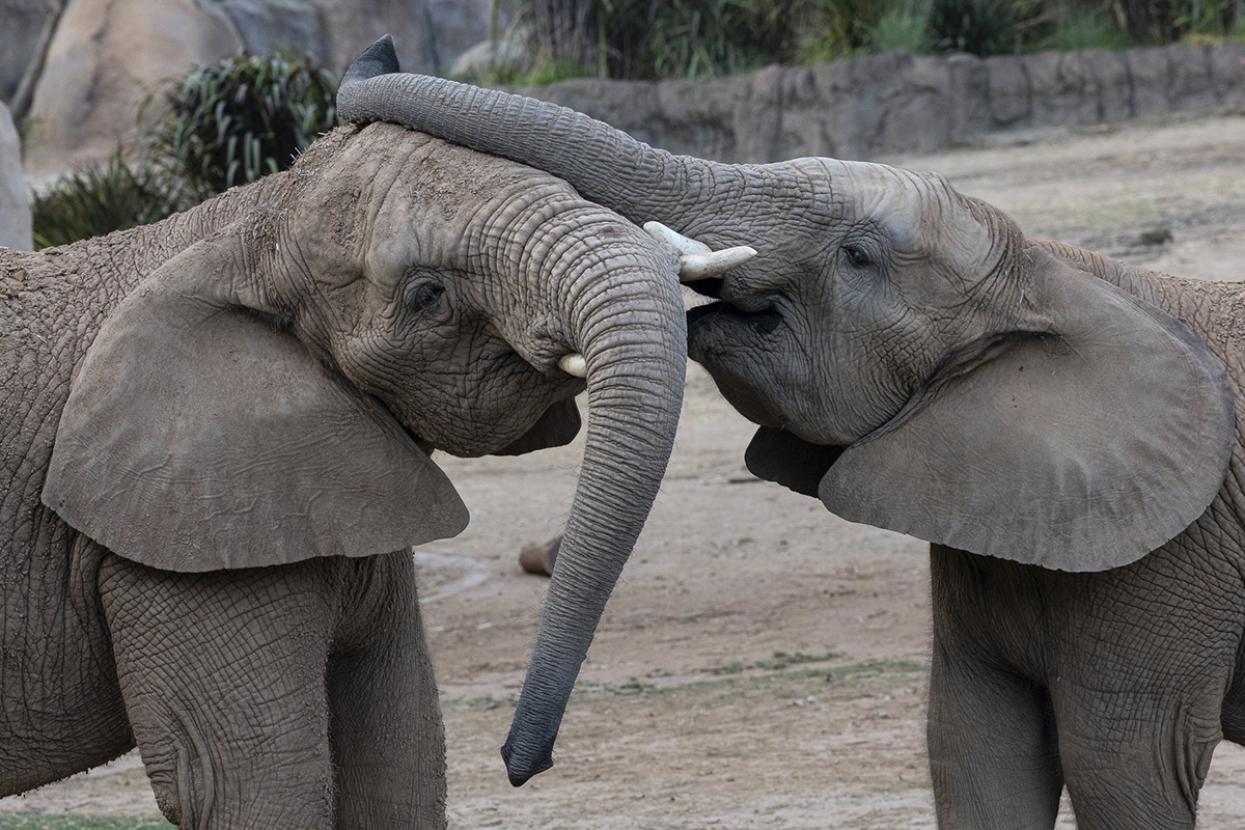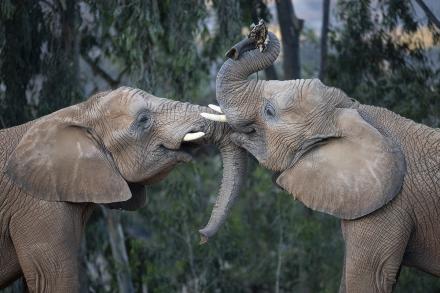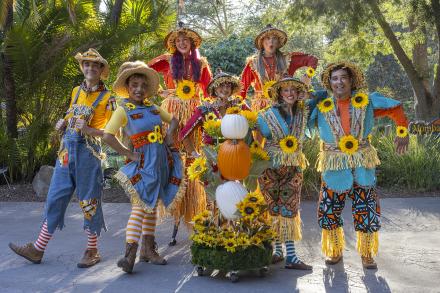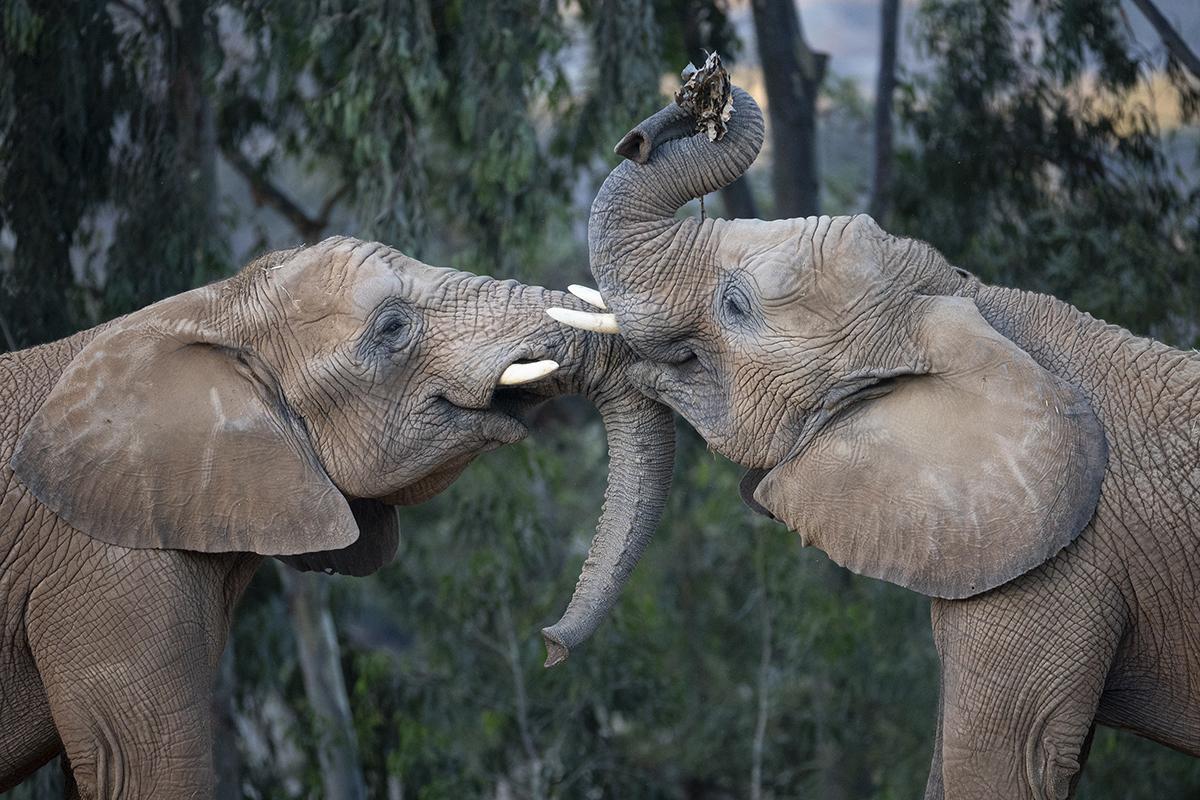
As the sun rises over the rolling hills of the San Diego Zoo Safari Park, a herd of elephants is already on the move. The matriarch, Swazi, gets first choice of the abundant resources spread across her lushly planted habitats. Tagging along is her daughter Qinisa (Nisa), eager to enjoy the perks of mom being in the top spot. Next is second-in-command Ndlulamitsi (Ndlula), who keeps an eye on the others as she and her young son Umzula-Zuli (Zuli) head for a different pile of browse. The third-ranking female, Umngani, calmly follows along with her daughter Mkhaya, happy to take whatever the others leave behind. Umngani’s older daughter, Khosi, wants to hang out with Nisa, so she heads over to see if Swazi will let her join them for breakfast. Phakamile (Kami) eats by herself for a bit before deciding to join Nisa and Khosi. These interactions are the first of hundreds the eight elephants will experience as they spend their day together at Denny Sanford Elephant Valley.
Elephants live in highly social groups led by an experienced matriarch. This herd's matriarch is Swazi (front left, next to daughter Nisa).
Elephants are highly social and live in multigenerational family groups made up of a matriarch and her sisters, aunts, and cousins, plus their female calves and young male calves. As with any complicated family, it helps if they can choose who they spend time with, and when. There are days they want to be together, and others where they prefer some alone time; they may go from peacefully sharing a sleeping space to trying to steal a snack. Even with the occasional disagreement, group members across native habitats depend on one another for resources, protection, and survival in their challenging African savanna environment. It takes a reliable leader to keep such a vibrant herd on track, which is where the matriarch comes in.
Matriarchs are the experts at finding resources. In a group where every enormous member can eat up to 7% of their body weight daily, they have to continuously engage with their environment to seek out what they need to thrive. Just as in native habitats, matriarchs like Swazi spend most of their lives investigating their habitats, and use their incredible long-term memories to recall all the best and safest spots for food, water, and shelter. Swazi uses these skills to guide her herd through their dynamic experiences and lives at Elephant Valley. They have to maneuver around clusters of plants, large boulders, and hidden water features as they search for food and other resources, and the other elephants know Swazi has her eye on the best spots.
The herd's youngest members, Mkhaya (left) and Zuli, grow up with care and guidance from the entire group.
Matriarchs are also the most experienced when it comes to identifying and responding to danger. In moments of uncertainty, the herd at Elephant Valley looks to each other. When they first saw a newly reimagined area of their habitats at Elephant Valley, their immediate reaction was to stop moving forward and instead come closer together. They entered the unfamiliar space clustered together and stayed that way as they explored. They quickly realized this area was actually full of amazing things for them to enjoy, so they spread out and settled in. The herd’s resilience and ability to adapt to new situations comes from feeling safe together and taking care of each other.
The foundation of this close-knit herd is the bond between the three oldest females: Swazi, Ndlula, and Umngani. They were rescued and welcomed to the Safari Park around the same time, so they have a respectful and trusting relationship, like sisters. When Ndlula had Zuli and Umngani had Mkhaya just six weeks apart, Swazi and the older female calves acted as babysitters, giving lots of care and attention to the small, clumsy newborns. Unlike male calves, who live with their mother’s herd until they reach maturity and are pushed out by the older elephants, females stay with their mothers their entire lives. As Kami, Khosi, Mkhaya, and Nisa grow and mature, they will become older aunties themselves, passing along their knowledge and guidance to another generation. These strong intergenerational relationships help the herd work together, adapt to changes, and always have each other’s backs.
PACHY FACT: Elephants walk on their toes. Behind their toes is a pocket of fatty tissue that acts like a shock absorber. That’s why they are so quiet!
Matriarch Swazi leads the herd with quiet confidence. From left: Ndlula, Khosi, Swazi, Nisa.
Leading by Example
The herd’s matriarch is typically the largest, strongest, or oldest female, but that is not the case with Swazi. Though she is one of the oldest and largest elephants in the group, she is also one of the kindest. She uses her quiet confidence to lead and support the herd. When a little one’s horseplay caused Ndlula to trip over a log, Ndlula got frustrated and chased him, trying to give him a swat. Another matriarch may have pushed away the offender, but Swazi got between them and stood there calmly until they quieted down. Just her presence, and a subtle flare of her ears, is enough to keep potential disagreements at bay. She will also intervene if there’s a perceived potential threat, even if it’s just soothing someone who got spooked by a rabbit jumping out behind them. When Swazi isn’t busy keeping the peace, she loves to swim, and will often bond with the younger ones by joining them for a pool party!
As the daughter of the herd's matriarch, Nisa knows she's in a top spot.
Swazi’s daughter, Nisa, is a bit of a princess. She knows mom is in the top spot, and that means she doesn’t have to be concerned about finding all the best snacks and opportunities throughout the day. The group responds to Swazi’s movements and defers to her wishes, so all Nisa has to do is follow along. Nisa also has a lot of friends, as the other elephants know they may also benefit if she favors them. Lower-ranking Kami thought she could improve her standing in the herd by building a better relationship with Swazi’s family, so when Nisa was born, she started babysitting her. Now she can sometimes enjoy the same browse and opportunities as Swazi if she comes over when Nisa is there.
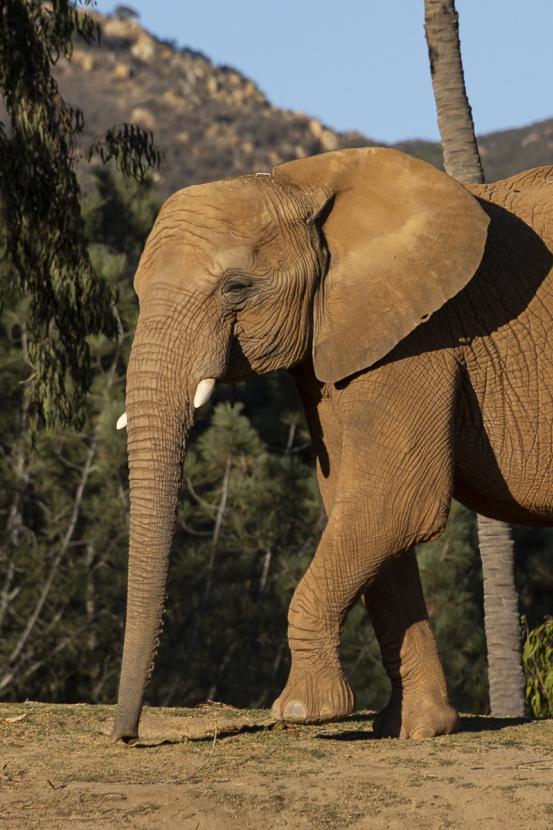
Kami is very alert and never misses anything going on.
Kami is also closely bonded with Swazi. She has very high social intelligence and knows that as the lowest-ranking female, she will benefit from a tight relationship with the highest-ranking female. Her lower position also means she has to stay alert, so she is very aware of her surroundings and never misses anything happening within the herd or her environment. She loves being around the younger calves, but if she notices strict Ndlula nearby, she might not go over to play with them until Ndlula has moved farther away.
PACHY FACT: An average-size elephant produces about 300 pounds of poop per day.
Ndlula (right) is second in command and keeps the little ones in line, especially her own son, Zuli (left).
A Force for Good
Powerful Ndlula is second-in-command and makes sure no one forgets it. She subtly tests Swazi by pushing her to follow through with her requests, but she also knows her place is subordinate to Swazi, and will yield prime browse if Swazi shows she’s interested in it. Ndlula is naturally a bit more confrontational than Swazi and isn’t afraid to make a point with the others. She’s only ever had male calves, who are typically more feisty and pushy than females, so their mothers tend to be a bit stricter to help guide and teach them as they grow older. This, along with her appreciation for consistency in her environment, makes her more of a rule-follower than the other mothers.
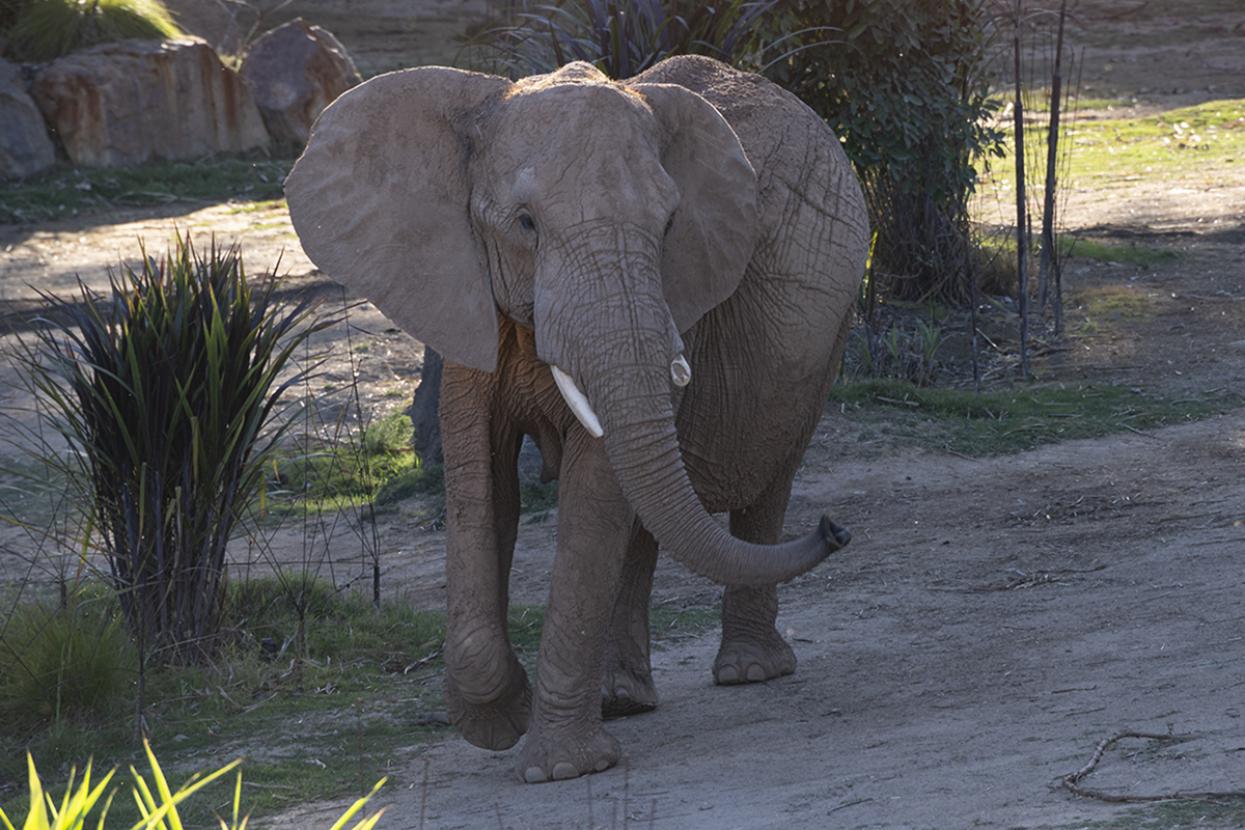
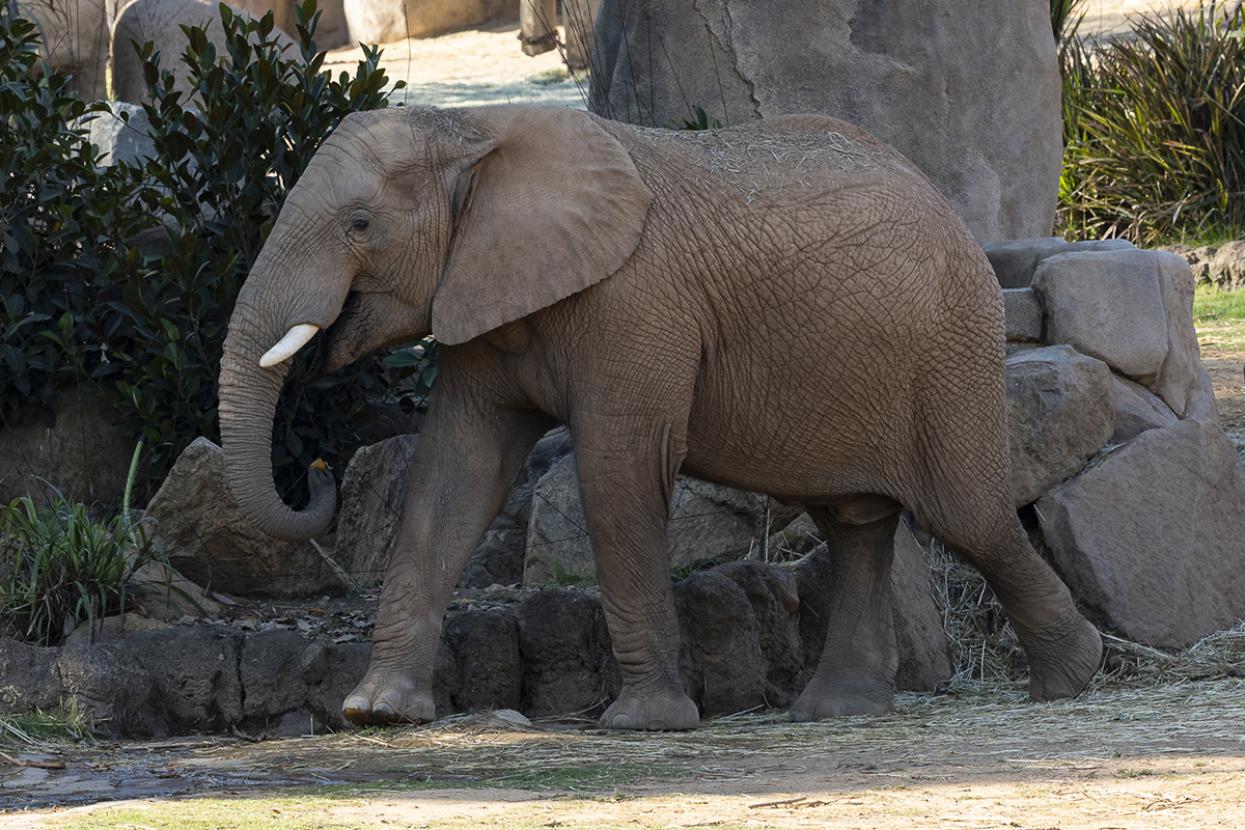
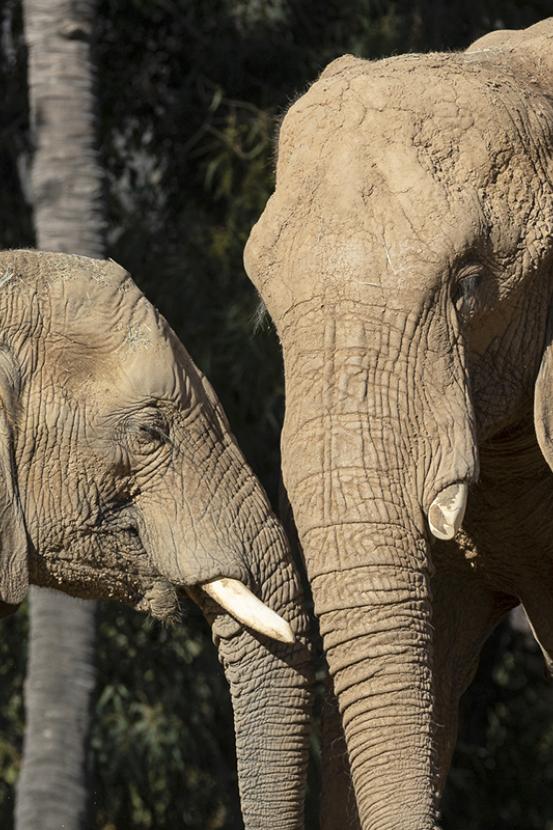
Young Zuli learns from watching his mother, Ndlula. Clockwise from top left: Ndlula; Zuli (left) and Ndlula; Zuli.
Ndlula keeps all the little ones in line, especially her own. When one of Ndlula’s young sons decided to knock Khosi down when she was just a few weeks old, Ndlula immediately pushed him away; even though he was still a calf himself, Ndlula knew she needed to teach him he couldn’t bully the females and younger calves. Her youngest son, Zuli, has learned from watching his mother and gets along well with the younger females. He loves to go swimming with them in the watering hole.
PACHY FACT: Elephants don’t have pores, so they can’t sweat. Their extra-wrinkly skin helps them stay cool. Taking baths or rolling in mud fills their wrinkles with water and dirt, which helps protect them from the sun.
Umngani (back middle) and her daughters, Mkhaya (front left) and Khosi (right), are content with their place in the herd.
Perky Ears, No Fear
The lady with the longest tusks is the lovely Umngani. As the least dominant of the three adult females, she has to be the most alert, so her ears are usually perked. She’s the herd’s patient, dedicated, and sweet-natured supermom whose daughters, Khosi and Mkhaya, round out her quirky, fun-loving family group. Umngani is very comfortable with her position in the group and doesn’t challenge the others; instead, she uses her resourcefulness and intelligence to cruise the area and pick up things others have left behind. Her calm contentedness has allowed her daughters to become very confident members of the herd, even though their mom has the lowest rank.
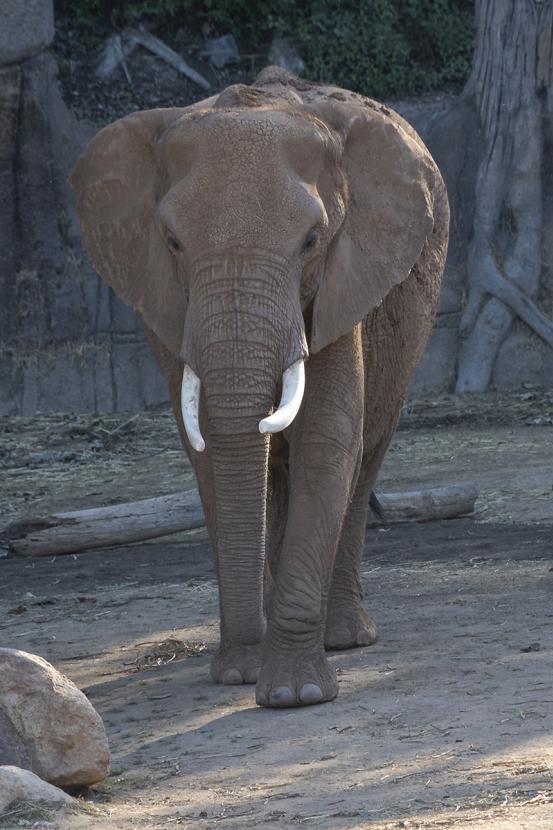
Umngani is patient and resourceful, and also has the longest tusks.
Umngani’s oldest daughter, Khosi, is easy to spot because she’s the unicorn—the only elephant with one tusk! Khosi was the herd’s first female calf, so everyone immediately adored her. The other adults were very protective of her, and all wanted to take turns babysitting her. Even as a teenager, she is still a social butterfly who has a great relationship with every adult in the group. She is confident and smart, and likes to take the herd on adventures. Along with Swazi, Khosi is the first to discover something going on in the habitat. When an underground pipe was leaking, she smelled it, dug it up, and turned the resulting geyser into a hollow filled with muddy fun for everyone! She’s first into the watering hole for an evening splash, and gets the other little ones to join her for a pool party. It’s no surprise she’s also the best babysitter.
Teenage Khosi is a social butterfly and loves to take the herd on adventures.
Khosi’s little sister, Mkhaya, is the youngest in the herd. She’s still nursing and a few years away from maturity, but she’s already a little spitfire who’s not afraid of anything. She’s very social and well-established within the group; everyone accepts her and lets her hang around them to eat.
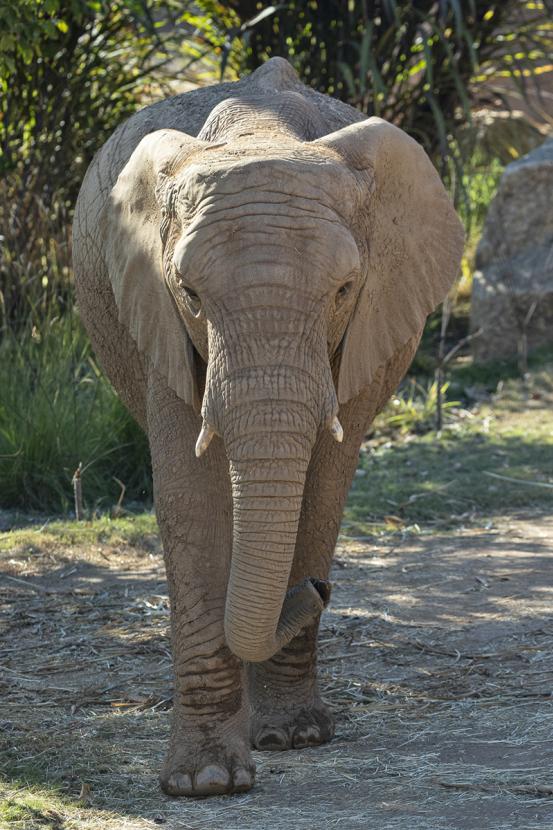
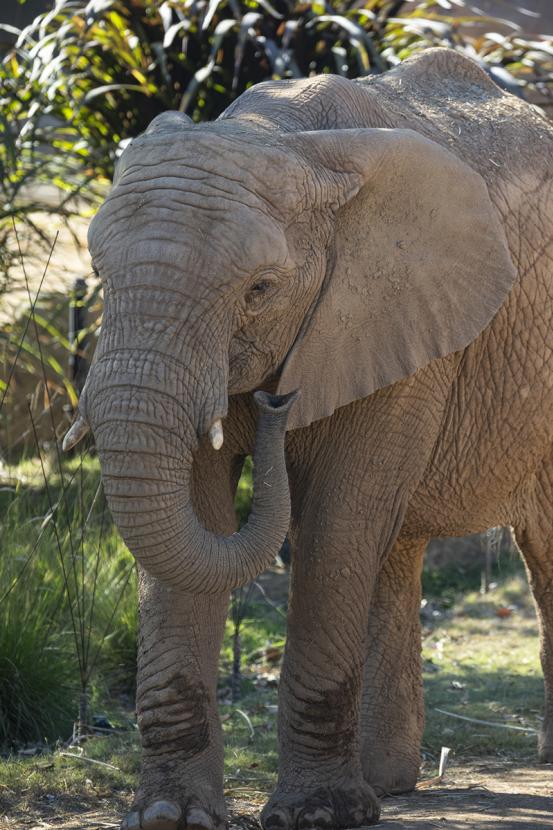
The herd's youngest member, Mkhaya, isn't afraid of anything.
Have you herd? There’s lots more to look forward to from Elephant Valley. Keep checking Story Hub and the Elephant Valley website for more details—including when you’ll be able to experience these incredible elephants yourself!
PACHY FACT: An elephant’s body has thick skin, but sensitive hairs. This means they can take big hits without bruising, but can still feel a fly walking across their back.
Experience incredible elephants, including Kami (left) and Zuli, when Elephant Valley opens at the Safari Park.

